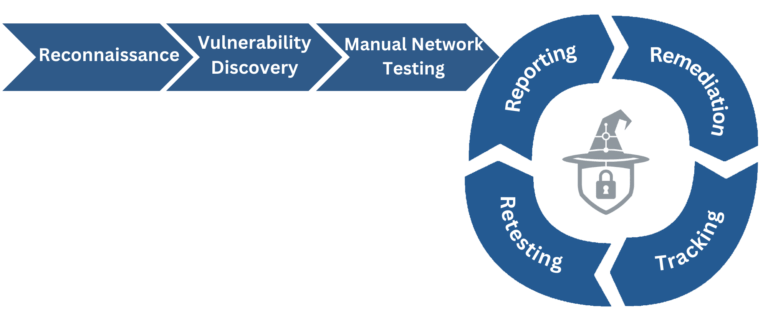Network Penetration Testing Explained
Network penetration testing is a critical cybersecurity practice aimed at identifying and addressing vulnerabilities within an organization’s network infrastructure. This proactive approach involves simulating cyber attacks under controlled conditions to evaluate the security of networks, including both wired and wireless configurations. By mimicking the strategies employed by cybercriminals, penetration testers can uncover potential weaknesses that could be exploited, ranging from system misconfigurations, software vulnerabilities, to inadequate security policies and procedures.

Reconnaissance
In external network penetration testing, the reconnaissance phase involves collecting information about the target’s external network infrastructure. Testers identify public resources like websites and mail servers, using DNS enumeration, IP range identification, and open port scanning with tools like Nmap. They also utilize public databases and online sources to gather organizational details. This phase aims to map the network’s perimeter, identify internet-exposed services, and pinpoint potential vulnerability entry points for deeper testing.
For internal network penetration testing, reconnaissance focuses on mapping the internal network once initial access is achieved. This includes using network scanners to identify devices such as servers and workstations and understanding network segmentation and security measures like firewalls. The goal is to uncover internal vulnerabilities and valuable assets, crucial for subsequent exploitation and movement within the network. This stage provides a comprehensive view of the internal network’s structure and security, essential for thorough testing and identifying key security improvement areas.

Automated Vulnerability Discovery
In the Automated Vulnerability Discovery phase of external network penetration testing, testers use automated scanning tools like Nessus or OpenVAS to identify vulnerabilities in the organization’s external network components. These tools scan external IP addresses and services, checking for issues such as outdated software, misconfigured servers, or unpatched systems, typical in public-facing infrastructures. This automated process provides a rapid, comprehensive assessment of the network, identifying weaknesses that external attackers could exploit. It’s a vital step for quickly highlighting vulnerabilities that threaten the organization’s external security perimeter and outlining the external attack surface.
For internal network penetration testing, this phase focuses on detecting vulnerabilities within the internal network. Testers, having gained access to the network, utilize automated scanners to find vulnerabilities for deeper network penetration and potential data breaches. This includes looking for vulnerabilities in internal servers, insecure protocols, or misconfigured network devices. The aim is to emulate an attacker who has penetrated the external defenses, searching for internal weaknesses that could lead to further exploitation and access to critical data. This phase is critical for gauging the internal network’s risk level and the possibility of lateral movement and accessing sensitive information.
Manual Testing and Exploitation
In the Manual Testing and Exploitation phase of network penetration testing, testers conduct an in-depth, hands-on examination of the network to uncover vulnerabilities that automated tools might overlook. This critical stage involves probing network components like firewalls, routers, and server services, using advanced techniques to identify complex issues such as misconfigurations and flawed access controls. This manual approach is key to understanding the potential impact and extent of exploitable vulnerabilities.
During the exploitation phase, testers simulate real attack scenarios to demonstrate the actual exploitation of these vulnerabilities. They attempt activities like privilege escalation, lateral network movement, and accessing sensitive data, mimicking a potential attacker’s actions. This step is essential for assessing the real-world risk and impact of the vulnerabilities, helping prioritize which issues need urgent remediation. The insights from this phase are vital for reinforcing the network’s defenses against genuine cybersecurity threats.
Reporting
In the Reporting phase of network penetration testing, findings and data are compiled into a detailed report. This report is essential as it thoroughly outlines all identified network vulnerabilities, their potential impacts, and the methods used for their detection and exploitation. It ranks each vulnerability by severity and risk, aiding the organization in prioritizing fixes. The report typically includes precise details such as the vulnerability’s network location, proof of concept for exploitations, and supporting evidence like logs or screenshots. Its main purpose is to provide actionable recommendations and clear directions for addressing and mitigating the identified security issues.
